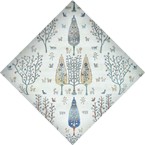Weavig Indo-Tibetan traditional rugs has existed for thousands of years. Political and religious exiles fled their ancient mountain kingdom in 1959, when a Chinese military uprising forced a mass exodus. They settled in areas below the Himalayas, like India and Pakistan, where they reside until this day. Most Indo-Tibetan traditional rug weaving takes place in this region although there are excellent weaving centers in Katmandu, Patan, and Pokhara. The best rugs are still made in the time honored fashion of traditional rug weaving with totally handspun Tibetan yarn and vegetable dyes, and hand woven using the unique Tibetan asymmetrical knot - a double looped knot called the sennah that originated on Himalayan plateaus. Indo Tibetan traditional rug weaving is totally unique in structure and design, largely influenced by the Tibetan tribal culture and to a lesser degree by Buddhism and Chinese culture.
Indo Tibetan rugs are well known for its lush geometric designs. Checkerboard rugs and back strap loom rugs called tsuktruk weavings became popular in the United States around 1990. Abstract, floral, garden, pictorial, plain, and classic animal print designs are also in high demand. The color palette on Indo-Tibetan rugs runs the gamut from neutral to extraordinarily brilliant. You will see everything from beiges and creams to oranges, reds, turquoise, and purples.
The foundation of an Indo-Tibetan rugs is hand spun cotton, while the pile is wool or a combination of wool and silk. These durable rugs are very thick and dense with deep pile and fabulous colors. Most of the rugs produced are small in size, although large ones are occasionally available. The simple geometric designs of Indo-Tibetan rugs lends itself to modern and contemporary décor, but they are so versatile that they can be used as floor coverings, runners, throws, and wall hangings in any home.
(9'4" x 12'1") Indian Indo-Tibetan
SKU 301-30832
(9'1" x 11'8") Indian Indo-Tibetan
SKU 301-30838
(9'4" x 12'6") Indian Indo-Tibetan
SKU 301-30837
(8'9" x 11'7") Indian Indo-Tibetan
SKU 301-30836
(9'0" x 12'0") Indian Indo-Tibetan
SKU 301-30860
(9'4" x 12'3") Indian Indo-Tibetan
SKU 301-30831
(9'0" x 11'10") Indian Indo-Tibetan
SKU 301-30866
(9'7" x 13'9") Indian Indo-Tibetan
SKU 301-30937
(9'0" x 11'8") Indian Indo-Tibetan
SKU 301-30870
(8'0" x 10'0") Tibetan Indo-Tibetan
SKU 100-22646
(9'8" x 13'9") Indian Indo-Tibetan
SKU 301-30938
(8'9" x 11'11") Indian Indo-Tibetan
SKU 301-30826
(9'0" x 11'9") Indian Indo-Tibetan
SKU 301-30854
(9'1" x 11'8") Indian Indo-Tibetan
SKU 301-30850
(9'2" x 12'0") Indian Indo-Tibetan
SKU 301-30868
(9'3" x 12'1") Indian Indo-Tibetan
SKU 301-30861
(9'0" x 11'8") Indian Indo-Tibetan
SKU 301-30869
(8'11" x 11'10") Indian Indo-Tibetan
SKU 301-30843
(8'9" x 11'10") Indian Indo-Tibetan
SKU 301-30835
(8'9" x 11'10") Indian Indo-Tibetan
SKU 301-30855
(9'0" x 12'0") Indian Indo-Tibetan
SKU 301-30829
(8'8" x 12'2") Indian Indo-Tibetan
SKU 301-30830
(9'9" x 13'9") Indian Indo-Tibetan
SKU 301-30902
(9'1" x 11'7") Indian Indo-Tibetan
SKU 301-30871
(12'0" x 15'1") Indian Indo-Tibetan
SKU 301-30990
(9'0" x 12'3") Indian Indo-Tibetan
SKU 301-30824
(9'3" x 12'3") Indian Indo-Tibetan
SKU 301-30825
(9'0" x 12'0") Indian Indo-Tibetan
SKU 301-30827
(9'9" x 13'11") Indian Indo-Tibetan
SKU 301-30941
(9'0" x 12'1") Indian Indo-Tibetan
SKU 301-30874
(8'6" x 11'3") Indian Indo-Tibetan
SKU 301-30873
(9'0" x 12'0") Indian Indo-Tibetan
SKU 301-30847
(8'10" x 11'10") Indian Indo-Tibetan
SKU 301-30859
(8'9" x 11'4") Indian Indo-Tibetan
SKU 301-30867
(9'4" x 12'0") Indian Indo-Tibetan
SKU 301-30834
(9'3" x 12'1") Indian Indo-Tibetan
SKU 301-30846
(8'9" x 11'5") Indian Indo-Tibetan
SKU 301-30833
(9'0" x 12'0") Indian Indo-Tibetan
SKU 301-30842
(8'11" x 11'8") Indian Indo-Tibetan
SKU 301-30841
(9'9" x 14'2") Indian Indo-Tibetan
SKU 301-30939
(8'9" x 11'6") Indian Indo-Tibetan
SKU 301-30858
(8'9" x 11'8") Indian Indo-Tibetan
SKU 301-30851























Be the first to know about new designs and
exclusive offers, and get up to
10% OFF
your first purchase

Rugman.com since 1998 | The first and oldest online rug store
You can unsubscribe with a single click. We value your privacy; click here for more info.

You have one more step to join
Rugman Insider Club.
A coupon code will be emailed to you.
Please check your email and just
click the green “Confirm Subscription” button.

